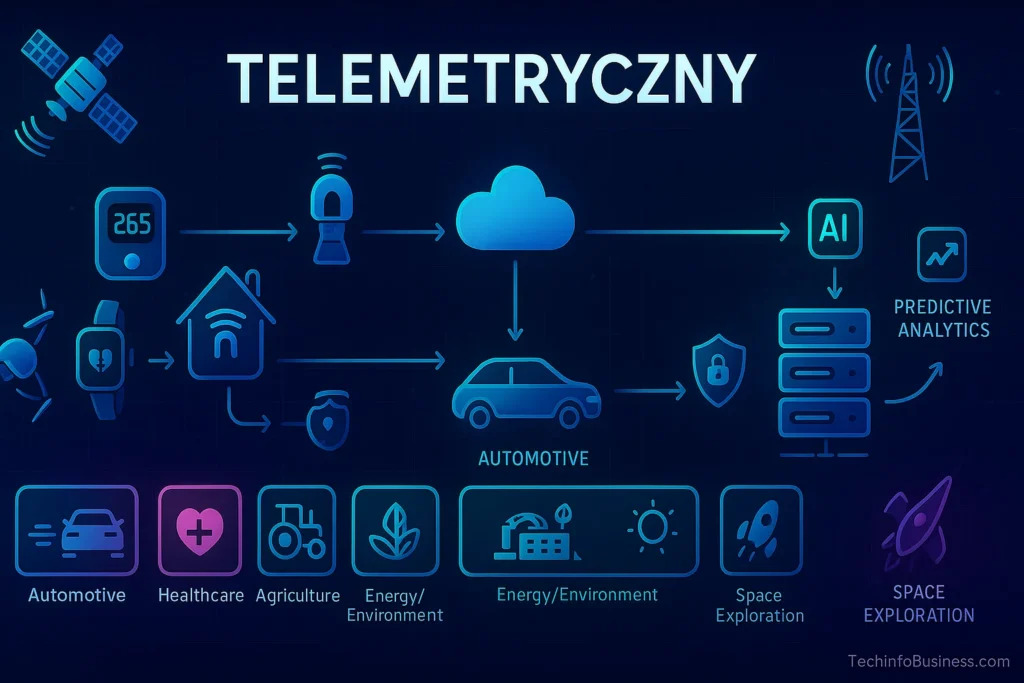
Telemetryczny
Table of Contents
Did you know that telemetryczny systems are set to hit over $42 billion in market value by 2025? These systems are changing how we get, analyze, and use real-time data in many fields in the United States.Here you can get detailed information about telemetryczny.

Telemetry systems are a new way to monitor things from far away and send data wirelessly. They give us deep insights into complex places, like hospitals and space projects.
In this guide, you’ll see how telemetryczny solutions are changing how we collect data. They give us important info that helps us innovate, stay safe, and make better choices in many areas.
Key Takeaways
- Telemetry systems are reshaping technological landscapes across industries
- Real-time data transmission enables faster, more accurate decision-making
- Diverse applications span healthcare, aerospace, manufacturing, and urban infrastructure
- Advanced telemetryczny technologies continue to evolve rapidly
- Strategic implementation offers significant competitive advantages
Understanding Modern Telemetry Systems
Telemetry systems have changed how we get and use data in many fields. They let us measure and watch things from far away with great accuracy and speed. Knowing about these systems can help us understand new tech better.
Modern telemetry systems are complex networks. They are made of many parts to catch, send, and handle important info. Their main job is to send data in real time, no matter where it is.
Basic Components of Telemetry Systems
Every telemetry system has key parts:
- Sensors for data collection
- Transmitters for wireless signal sending
- Receivers for signal interpretation
- Data processing units for analysis
Data Transmission Methods
Wireless tech has made sending data better. Now, groups use many ways to send info:
| Transmission Method | Primary Use | Range |
|---|---|---|
| Radio Frequency | Short to Medium Distance | 10-50 miles |
| Satellite Networks | Global Coverage | Worldwide |
| Cellular Networks | Urban and Suburban Areas | Regional |
Real-time Monitoring Capabilities
The best thing about telemetry systems is they can analyze data right away. They let us measure things from far away. This helps us make quick decisions.
“Telemetry transforms raw data into actionable intelligence” – Tech Innovation Report 2024
Evolution of Telemetryczny Technologies in America
The history of telemetric devices in the U.S. is amazing. It started with simple mercury pressure gauges in the 1700s. Now, we have advanced sensor networks that change how we gather and study data in many fields.
World War II was a big turning point for telemetry. Military teams created new sensor networks. They tracked planes, missiles, and communication systems. These early steps led to today’s telemetric tech.
- 1763: First mercury pressure gauges introduced
- 1940s: Military-driven telemetry development
- 1960s: Transition from analog to digital systems
- 2000s: Advanced wireless sensor networks emerge
The Cold War made telemetric tech even better. Space and defense research led to more accurate monitoring tools. By the 1980s, digital tech changed telemetry. It allowed for quicker data sharing and deeper analysis.
Now, sensor networks are key in many areas, like healthcare and manufacturing. With artificial intelligence and machine learning, telemetry will keep getting smarter. This will make data collection even more effective.
Industrial Applications and Manufacturing
Telemetry has changed how companies watch, control, and make things better. It’s key to understanding today’s advanced manufacturing. Real-time monitoring plays a big role in these systems.
Telemetry technologies bring new levels of precision and efficiency. They let industries collect and analyze data fast. This is across big production networks.
Factory Automation Solutions
Modern factory automation uses telemetry systems a lot. These systems give manufacturers deep insights into:
- Machine performance metrics
- Operational efficiency tracking
- Predictive maintenance scheduling
- Energy consumption analysis
Quality Control Monitoring
Real-time monitoring has changed quality control. It lets manufacturers spot defects right away. This cuts down on waste and keeps products up to standard.
- Instant defect detection
- Automated inspection systems
- Statistical process control
- Continuous improvement tracking
Production Line Integration
Remote sensing makes production lines work together smoothly. This connected way helps with:
- Synchronized manufacturing processes
- Enhanced data-driven decision making
- Reduced operational bottlenecks
- Improved overall equipment effectiveness
By using these telemetry innovations, manufacturers can get more productive. They can stay ahead in a complex industrial world.
Healthcare and Medical Monitoring Solutions
Telemetryczny technologies are changing patient care in today’s hospitals. Wireless monitoring systems are key for doctors. They let them track patient vital signs and health in real time.
Healthcare teams use advanced telemetry to keep patients safe and get better results. These systems bring many benefits:
- Continuous remote patient monitoring
- Early detection of health risks
- Lower hospital readmission rates
- Custom medical care
Biotelemetry has changed heart care a lot. Patients with heart issues can be watched all the time. This is thanks to wireless devices that send important data to doctors.
| Telemetry Application | Healthcare Impact |
|---|---|
| Cardiac Monitoring | 24/7 heart rhythm tracking |
| Chronic Disease Management | Real-time health parameter tracking |
| Post-Surgical Monitoring | Remote patient recovery assessment |
Wearable medical devices with telemetryczny tech are changing preventive care. These smart devices track heart rate, blood pressure, and glucose levels. They give deep insights into patient health.
The future of healthcare is in proactive, data-driven monitoring. It empowers both patients and doctors.
Aerospace and Defense Applications
Telemetry systems are key in aerospace and defense. They give deep insights into complex areas. These systems change how teams get, analyze, and use important info.
Military Intelligence Systems
In the military, telemetry systems help gather real-time info. They use advanced tech to:
- Track important equipment
- Watch troop movements
- Check battlefield conditions fast
Aircraft Performance Monitoring
Aerospace engineers use top-notch telemetry systems for flight tests. Real-time data transmission spots mechanical issues, boosts fuel use, and makes flying safer.
Space Exploration Data Collection
NASA and others use advanced telemetry for space missions. They get vital data on:
- Spacecraft conditions
- Instrument work
- Radiation levels
- Structural health
Telemetry tech lets us explore space like never before. It expands our scientific knowledge.
Environmental and Agricultural Monitoring

Telemetry technologies are changing how we care for the environment and farm. They help us understand and protect nature. They also make farming more efficient.
In wildlife research, sensor networks give us new insights. They let us track animals and their homes with great detail. This helps us learn about endangered species.
- Wildlife tracking using GPS-enabled sensor networks
- Real-time ecosystem health monitoring
- Precise migration pattern analysis
Precision agriculture has changed farming with new tech. Farmers use advanced sensors to manage crops better. They save water and make farming more efficient.
- Soil moisture monitoring systems
- Automated weather prediction tools
- Intelligent pest management solutions
Telemetry is key to understanding today’s environmental and farming practices. It helps us quickly respond to environmental changes. This protects nature and boosts food production.
“Sensor networks are the eyes and ears of modern environmental science and agricultural management” – Environmental Technology Research Institute
By 2025, remote measurement tech will be even more important. It will help us keep the environment safe and improve farming.
Smart City Infrastructure and Urban Planning
Telemetric devices are changing cities in the United States. They make cities smarter and more responsive. Real-time monitoring is key to managing infrastructure and improving life for citizens.
Cities use advanced systems to make urban spaces better. These systems collect and analyze data. This helps cities make smarter choices.
Traffic Management Systems
Modern traffic management uses real-time data to cut down on traffic and make roads safer. Telemetric devices track cars and analyze traffic. This gives planners important insights.
- Adaptive traffic signal control
- Automated incident detection
- Predictive traffic flow modeling
Public Safety Networks
Telemetric devices boost emergency response. Police and firefighters get real-time location data. This helps them act faster and more effectively.
Utility Distribution Monitoring
Smart cities monitor utilities in real-time. Telemetric systems track energy, water, and gas use. This cuts waste and improves resource use.
By 2025, telemetry will be fundamental to creating more responsive and efficient urban environments.
Remote Asset Management and Tracking
Remote asset management has changed how businesses track and monitor important things. Wireless monitoring lets companies see their assets better. This makes work more efficient and cuts down on maintenance costs.
Remote sensing is key in managing assets. It helps in:
- Fleet tracking and logistics optimization
- Pipeline and utility infrastructure monitoring
- Equipment performance diagnostics
- Geographic resource allocation
Today’s telemetry systems use advanced wireless monitoring. They give real-time data. Companies can track assets over big areas with great accuracy. They can spot problems early.
| Industry | Remote Monitoring Benefits | Key Performance Indicators |
|---|---|---|
| Oil and Gas | Equipment health tracking | Reduced downtime, predictive maintenance |
| Transportation | Vehicle location and performance | Fuel efficiency, route optimization |
| Renewable Energy | Power generation monitoring | Output tracking, maintenance scheduling |
By 2025, remote sensing will keep changing how we manage assets. Wireless monitoring solutions give businesses an edge. They get better at working and making quick decisions.
Energy Sector Applications

The energy sector is changing fast with new telemetryczny data tech. These systems are changing how we watch over power networks, green energy, and how resources move in the U.S.
Power Grid Monitoring Innovations
Modern telemetryczny systems give us key info on power grid health. Now, utility companies use real-time data to:
- Spot problems before they happen
- Balance loads better
- Plan for maintenance
- Save energy
Renewable Energy System Integration
Green energy needs exact monitoring. Wind farms and solar setups use top-notch data tech to track:
- How much energy they make
- How well their gear works
- How they affect the environment
- How much power they can make right now
Resource Distribution Network Management
Telemetryczny tech is changing how we manage oil, gas, and water. These smart networks help track everything, making sure resources are used right and keeping things running smoothly.
“Telemetry is the backbone of modern energy infrastructure, providing unprecedented visibility and control.” – Energy Technology Research Institute
By 2025, these telemetryczny systems will keep making energy better, more reliable, and greener.
Automotive Industry Implementation
Telemetry systems have changed the car world a lot. They help make cars better, test them, and improve their performance. In racing, they give race engineers key data fast. This data can win or lose a race.
Telemetry is not just for racing anymore. Now, cars for regular people use it too. It makes cars safer, better to drive, and more fun. It also helps with:
- Advanced driver assistance systems
- Predictive maintenance tracking
- Real-time vehicle diagnostics
- Enhanced safety features
Big car makers like Tesla, Ford, and BMW lead in using new telemetry tech. They use it to gather lots of data from cars. This helps them know how cars work, find problems early, and make cars better.
The future of cars and telemetry is exciting. Real-time monitoring will be key for self-driving cars. They will make quick choices based on lots of data. By 2025, telemetry will get even better, changing how we see cars.
Future Trends and Technological Advancements
The world of telemetric devices and sensor networks is changing fast. By 2025, new tech will change how we use data. This will affect many industries.
New tech brings big chances for better data use and smart systems. Knowing about these changes is key to understanding the future.
Emerging Technologies in Telemetry
- 5G connectivity enables fast data sharing
- Edge computing means quicker processing
- Advanced IoT platforms improve connection
- Quantum sensing brings new insights
AI Integration Prospects
Artificial intelligence is changing telemetric devices. It adds smart analysis. Now, machines can:
- Spot problems before they start
- Make sensors work better
- Make choices on their own
Industry 4.0 Integration
Telemetry and Industry 4.0 are coming together. This makes smart systems in many areas like making things, health care, and building things.
| Technology | Impact | Projected Growth |
|---|---|---|
| Digital Twin Technology | Real-time system mirroring | 35% by 2026 |
| Predictive Maintenance | Less downtime | 25% more efficient |
| Smart Sensor Networks | Better data collection | 40% market growth |
These changes mark a big shift for telemetric tech. Smart systems will lead to huge gains in efficiency and new ideas.
Conclusion
Telemetryczny systems are changing many industries in the United States. They bring new insights and ways to work better. This is true in healthcare and aerospace, among others.
Telemetry does more than just collect data. It helps make better choices, improve safety, and make systems more responsive. This is in areas like energy, manufacturing, and city planning. The use of artificial intelligence and sensors is making things even more exciting.
Looking ahead to 2025, the possibilities for telemetry are endless. But, we will face challenges like keeping data safe and making standards. Yet, there are great chances for those who know about these systems. By keeping up and being flexible, you can lead in this tech change.
Knowing about telemetry is not just about tech. It’s a way to change how industries work and grow. The future is for those who use smart, connected systems to turn data into useful information.
FAQ
What exactly is telemetryczny, and how does it differ from traditional monitoring systems?
Telemetryczny is a new way to measure things from far away. It sends data wirelessly in real time. This is different from old systems that don’t work as fast.
How are telemetry systems used in healthcare?
In healthcare, telemetry helps keep an eye on patients all the time. It tracks important signs and how medicines work. It also lets doctors check on patients from afar.
What industries benefit most from telemetry technologies?
Many fields use telemetry, like aerospace, healthcare, and more. It helps them watch things in real time. This makes things work better and helps make smart choices.
How do telemetry systems contribute to environmental conservation?
Telemetry helps the environment by tracking animals and weather. It also helps with farming and studying the climate. This gives us better data to protect nature.
What are the key components of a telemetry system?
A telemetry system has sensors, senders, networks, and computers. These parts work together to send data from far away. They use wireless tech like radio and cell phones.
Are there privacy concerns associated with telemetry technologies?
Yes, there are privacy worries, mainly in health and personal tracking. Companies must keep data safe. They need to follow rules like HIPAA.
How is artificial intelligence transforming telemetry systems?
AI is changing telemetry by making it smarter. It does predictions and makes decisions on its own. This helps in many fields.
What future trends are expected in telemetry technologies?
New things like 5G and AI are coming. These will make telemetry systems better. They will work more together and be more efficient.
How do telemetry systems improve industrial manufacturing?
Telemetry makes factories better by watching equipment closely. It helps fix things before they break. This makes production smoother and more efficient.
What role do telemetry systems play in smart city development?
Telemetry is key for smart cities. It helps with traffic, safety, and utilities. It makes cities work better and be more green.
Also Read:
Best Late Night Food in the US: Top Midnight Meal Spots in 2025
Wat Wax Uses and Benefits with Complete Safety Guide 2025
Popping Boba – Refreshing Flavors and Fun Bubble Tea Toppings 2025
Best Late Night Food in the US: Top Midnight Meal Spots in 2025




